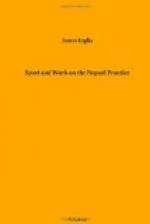The varieties of trees are of course almost innumerable, but the sal is so out of all proportion more numerous than any other kind, that the forests well deserve their recognised name. The sal is a fine, hard wood of very slow growth. The leaves are broad and glistening, and in spring are beautifully tipped with a reddish bronze, which gradually tones down into the dingy green which is the prevailing tint. The sheshum or sissod, a tree with bright green leaves much resembling the birch, the wood of which is invaluable for cart wheels and such-like work, is occasionally met with. There is the kormbhe, a very tough wood with a red stringy bark, of which the jungle men make a kind of touchwood for their matchlocks, and the parass, whose peculiarity is that at times it bursts into a wondrous wealth of bright crimson blossom without a leaf being on the tree. The parass tree in full bloom is gorgeous. After the blossom falls the dark-green leaves come out, and are not much different in colour from the sal. Then there is the mhowa, with its lovely white blossoms, from which a strong spirit is distilled, and on which the deer, pigs, and wild bear love to feast. The peculiar sickly smell of the mhowa when in flower pervades the atmosphere for a great distance round, and reminds one forcibly of the peculiar sweet, sickly smell of a brewery. The hill sirres is a tall feathery-looking tree of most elegant shape, towering above the other forest trees, and the natives strip it of its bark, which they use to poison streams. It seems to have some narcotic or poisonous principle, easily soluble in water, for when put in any quantity in a stream or piece of water, it causes all the fish to become apparently paralyzed and rise to the surface, where they float about quite stupified and helpless, and become an easy prey to the poaching ‘Banturs’ and ‘Moosahurs’ who adopt this wretched mode of fishing.
Along the banks of the streams vegetation gets very luxurious, and among the thick undergrowth are found some lovely ferns, broad-leaved plants, and flowers of every hue, all alike nearly scentless. Here is no odorous breath of violet or honeysuckle, no delicate perfume of primrose or sweetbriar, only a musty, dank, earthy smell which gets more and more pronounced as the mists rise along with the deadly vapours of the night. Sleeping in these forests is very unhealthy. There is a most fatal miasma all through the year, less during the hot months, but very bad during and immediately after the annual rains; and in September and October nearly every soul in the jungly tracts is smitten with fever. The vapour only rises to a certain height above the ground, and at the elevation of ten feet or so, I believe one could sleep in the jungles with impunity; but it is dangerous at all times to sleep in the forest, unless at a considerable elevation. The absence of all those delicious smells which make a walk through the woodlands at home so delightful, is conspicuous in the sal forests, and another of the most noticeable features is the extreme silence, the oppressive stillness that reigns.




